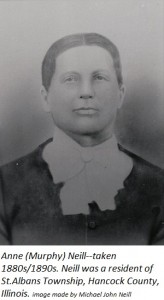- in 1865 Anne Murphy married Samuel Neill in St. John, New Brunswick. Civil and religious copies of the marriage record have been located. Research on the bondsman (Edward Durbin) is incomplete at this point and it is not known if he is related to either Samuel or Anne. There is no information on Anne’s origins in either of the marriage records.
- 1870 census (St. Alban’s Township, Hancock County, Illinois) indicated she was an Irish native aged 24.
- 1880 census (St. Alban’s Township, Hancock County, Illinois) indicated she was an Irish native aged 35.
- Anne’s 1890 era death certificate only indicated she was born in Ireland with an age consistent with her census.
- Apparently none of Anne’s Murphy relatives came to Hancock County, Illinois. She and her husband apparently moved to Hancock County, Illinois, because her sister-in-law, Annie (Brice) Neill already had Irish relatives who had settled in the area.
The conclusion is that Anne was born around 1845 in Ireland. At this point, it has been decided to research the bondsman on the marriage further.


6 Responses
I am curious to see how the research of the bondsman will help. I have the same problem with my Irish great grandmother born in Canada, orphaned at 6 years old and raised by “relatives.” She is from a large renown (Canniff) family in Canada, yet I cannot connect her to any of them. The name of the relatives she lived with are different from the family name signifying it may be a married aunt… I’ve been to SLC Family History Library researching only her, and have come up empty handed. I am back to DNA being my only hope. I have one DNA connection to the Canniff family but have not been able to connect her to my great grandmother. So I am curious to see what happens in researching the bondsman does.
There is a remote chance he had some connection to the family. Legally he would have had to have had knowledge that the bride and groom had no legal impediment to marriage. This doesn’t necessarily mean that he had any connection to the bride or groom “across the pond.” As mentioned in the blog post, I’ve exhausted other easier avenues to determining where Anne Murphy was from. The bondsman is one of those people who interacted with the couple early in their life in the new world that I have not researched fully for a potential connection to the family. I’ll post an update when I have one. I’m not crossing my fingers, but it is worth checking out.
You mention that the bondsman would have to have prior knowledge, legally, that the bride and groom had no legal impediment to marriage… we might assume that but really, how many ministers passed up a couple bucks to marry a young couple… the laws never come back on the minister for helping to create a bigamist; it’s the individual who is charged.
I have found people in my tree who were married in Wales or England and once in America presented themselves as single or widowed and married again. I’ve even found thorough (British) newspaper articles where the abandoned wife filed for divorce but never followed through because of her own problems… if no one complained there was nothing stopping people from creating a new life as a single person ready to be wed once they were in the states.
The minister did not grant the license or the permission to marry. The state did. Once the license to marry has been granted, the minister performs the ceremony. The license authorizes any legal officiant to marry the couple (ministers, justices of the peace, etc.) based upon the issuance of a license and that’s what happened in this case. In areas where licenses are issued, the minister isn’t on the hook at all if the couple has a license. The bondsman is saying that to the best of his knowledge there’s no legal impediment to the marriage. If it comes to pass that there was a legal reason one of the marrying couple couldn’t marry, the bondsman is on the hook legally or at the very least has created a potential legal obligation for himself by signing the bond.
I’m not saying that people didn’t get married who were under age or already married. They most certainly did. But in some locations, bonds weren’t part of the marriage process–the marrying parties simply stated they were “eligible” to marry. That’s a whole different sort of situation than having someone else vouch for you. It’s much easier to get married underage or with a wife two counties over if you are doing it in a location where bonds are not involved and all you have to do is tell the clerk “I’m old enough.” I’d be curious to see marriages involving a party who was ineligible where a marriage bond was a part of the process.
I misspoke myself and spoke of the bondsman and minister as the same person… not what I meant, forgive me. The two people in my family were married in 1873 in Virginia and the marriage is recorded at the local courthouse. I don’t have an actual copy of the record but an index of it is available on ancestry and is on film with the LDS. Later, the man’s first wife, living in England, divorced him in 1880. Their divorce records are now on ancestry; I had previously relied on the newspaper articles about the first wife.
That’s ok. It made for a good discussion anyway. In the mid-19th century most states that still required bondsmen stopped using the practice. I’m now sort of wondering why–which I really hadn’t thought about too much before you asked the question. By 1873 in VA I’m pretty certain (but not 100%) that they weren’t using bonds like they did earlier. Not requiring bonds made it easier to get married in general I would guess.